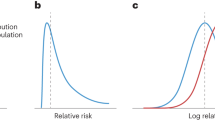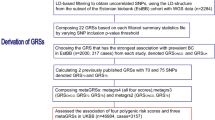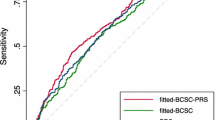Abstract
In the biology of complex disorders, such as breast cancer, interactions among genetic factors may play an important role and theoretical considerations suggest that gene–gene interactions are quite common in such diseases. In this case-control study with 500 breast cancer patients and 500 population-based healthy sex- and age-matched control subjects, we applied a multigenic approach to examine the associations with breast cancer risk of a comprehensive panel of 16 selected polymorphisms in a variety of pathways using classification tree analysis (CART). Overall, 79.6% of all breast cancer patients and 80.6% of all control subjects were correctly classified on the basis of their individual genetic profile by the classification procedure. CART analysis of the data identified the heterozygous vascular endothelial growth factor (VEGF) and matrix metalloproteinase 3 (MMP3) genotype and homozygous cyclooxygenase-2 (PTGS2) mutant as the initial splits, indicating that these genotypes exert the greatest impact on the classification process. Breast cancer patients were primarily indicated by 30 distinct genetic profiles. The odds ratio of these genetic risk profiles for breast cancer was 16.12 (95% confidence interval 11.09–23.49). Five genetic profiles formed homogenous breast cancer subgroups and represented highest risk genetic profiles. This is the first comprehensive study to use a multigenic analysis for breast cancer and the data suggest that individuals with distinct genetic profiles are at an increased risk for breast cancer, confirming the importance of taking a multigenic approach for risk assessment.

Similar content being viewed by others
References
Greenlee RT, Hill-Harmon MB, Murray T et al (2001) Cancer statistics. CA Cancer J Clin 51(1):15–36
Collaborative Group on Hormonal Factors in Breast Cancer (1997) Breast cancer and hormone replacement therapy: collaborative reanalysis of data from 51 epidemiological studies of 52,705 women with breast cancer and 108,411 women without breast cancer. Collaborative Group on Hormonal Factors in Breast Cancer. Lancet 350(9084):1047–1059
Collaborative Group on Hormonal Factors in Breast Cancer (1996) Breast cancer and hormonal contraceptives: collaborative reanalysis of individual data on 53 297 women with breast cancer and 100 239 women without breast cancer from 54 epidemiological studies. Collaborative Group on Hormonal Factors in Breast Cancer. Lancet 347(9017):1713–1727
Hulka BS, Stark AT (1995) Breast cancer: cause and prevention. Lancet 346(8979):883–887
Kelsey JL (1993) Breast cancer epidemiology: summary and future directions. Epidemiol Rev 15(1):256–263
Potter J (1997) World cancer research fund—American institute of cancer research. Food, nutrition and the prevention of cancer: a global perspective. Banta Book Group, Mebasha, USA
Antoniou AC, Pharoah PD, McMullan G et al (2001) Evidence for further breast cancer susceptibility genes in addition to BRCA1 and BRCA2 in a population-based study. Genet Epidemiol 21(1):1–18
Rannala B (2001) Finding genes influencing susceptibility to comples diseases in the post-genome era. Am J Pharmacogenomics 1(3):203–221
Zhang H, Bonney G (2000) Use of classification trees for association studies. Genet Epidemiol 19(4):323–332
Popanda O, Schattenberg T, Phong CT et al (2004) Specific combinations of DNA repair gene variants and increased risk for non-small cell lung cancer. Carcinogenesis 25(12):2433–2441
Han J, Colditz GA, Samson LD et al (2004) Polymorphisms in DNA double-strand break repair genes and skin cancer risk. Cancer Res 64(9):3009–3013
Gu J, Zhao H, Dinney CP et al (2005) Nucleotide excision repair gene polymorphisms and recurrence after treatment for superficial bladder cancer. Clin Cancer Res 11(4):1408–1415
Cheng TC, Chen ST, Huang CS et al (2005) Breast cancer risk associated with genotype polymorphism of the catechol estrogen-metabolizing genes: a multigenic study on cancer susceptibility. Int J Cancer 113(3):345–353
Esterbauer H, Schneitler C, Oberkofler H et al (2001) A common polymorphism in the promoter of UCP2 is associated with decreased risk of obesity in middle-aged humans. Nat Genet 28(2):178–183
Langsenlehner U, Yazdani-Biuki B, Eder T et al (2006) The cyclooxygenase-2 (PTGS2) 8473T > C polymorphism is associated with breast cancer risk. Clin Cancer Res 12(4):1392–1394
Langsenlehner U, Renner W, Yazdani-Biuki B et al (2006) Integrin alpha-2 and beta-3 gene polymorphisms and breast cancer risk. Breast Cancer Res Treat 97(1):67–72
Langsenlehner U, Krippl P, Renner W et al (2005) Interleukin-10 promoter polymorphism is associated with decreased breast cancer risk. Breast Cancer Res Treat 90(2):113–115
Krippl P, Langsenlehner U, Samonigg H et al (2004) Vascular endothelial growth factor in predicting outcome in breast cancer. Clin Cancer Res 10(24):8752–8753
Krippl P, Langsenlehner U, Renner W et al (2004) Re: Polymorphisms of death pathway genes FAS and FASL in esophageal squamous-cell carcinoma. J Natl Cancer Inst 96(19):1478–1479
Langsenlehner U, Krippl P, Renner W et al (2004) Genetic variants of the sulfotransferase 1A1 and breast cancer risk. Breast Cancer Res Treat 87(1):19–22
Krippl P, Langsenlehner U, Renner W et al (2004) The 5A/6A polymorphism of the matrix metalloproteinase 3 gene promoter and breast cancer. Clin Cancer Res 10(10):3518–3520
Krippl P, Langsenlehner U, Renner W et al (2004) The 825C > T polymorphism of the G-protein beta-3 subunit gene (GNB3) and breast cancer. Cancer Lett 206(1):59–62
Krippl P, Langsenlehner U, Renner W et al (2003) The 870G > A polymorphism of the cyclin D1 gene is not associated with breast cancer. Breast Cancer Res Treat 82(3):165–168
Krippl P, Langsenlehner U, Renner W et al (2003) The L10P polymorphism of the transforming growth factor-beta 1 gene is not associated with breast cancer risk. Cancer Lett 201(2):181–184
Langsenlehner U, Krippl P, Renner W et al (2003) The common 677C > T gene polymorphism of methylenetetrahydrofolate reductase gene is not associated with breast cancer risk. Breast Cancer Res Treat 81(2):169–172
Krippl P, Langsenlehner U, Renner W et al (2003) A common 936 C/T gene polymorphism of vascular endothelial growth factor is associated with decreased breast cancer risk. Int J Cancer 106(4):468–471
Breiman L, Friedman J (1984) Classification and regression trees. Pacific Grove, Wadsworth
Steinberg D, Colla P (1995) CART: tree-structured non-parametric data analysis. Salford Systems, San Diego
Acknowledgment
Armin Gerger and Uwe Langsenlehner contributed equally to this work.
Author information
Authors and Affiliations
Corresponding author
Additional information
Armin Gerger and Uwe Langsenlehner contributed equally to this work
Rights and permissions
About this article
Cite this article
Gerger, A., Langsenlehner, U., Renner, W. et al. A multigenic approach to predict breast cancer risk. Breast Cancer Res Treat 104, 159–164 (2007). https://doi.org/10.1007/s10549-006-9408-4
Received:
Accepted:
Published:
Issue Date:
DOI: https://doi.org/10.1007/s10549-006-9408-4




